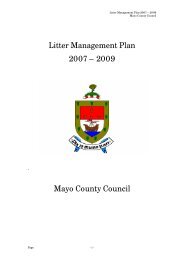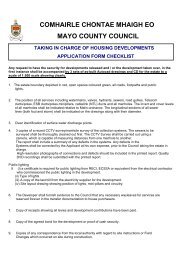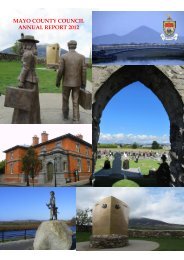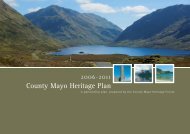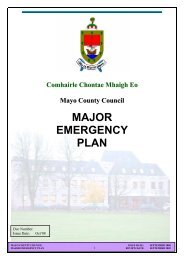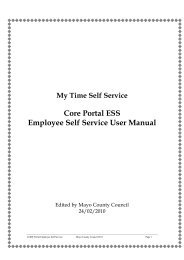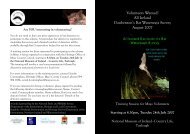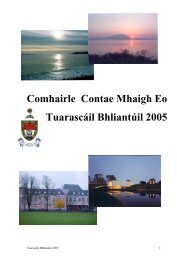Appendix K - Discharge Report
Appendix K - Discharge Report
Appendix K - Discharge Report
You also want an ePaper? Increase the reach of your titles
YUMPU automatically turns print PDFs into web optimized ePapers that Google loves.
CORRIB ONSHORE PIPELINEDISCHARGE WATER QUALITY EVALUATION REPORTFINAL REPORTPrepared for:SHELL E & P IRELAND LTDREPORT NO.: COR-14-OP-SH-0000
DOCUMENT INFORMATIONDOCUMENT TITLE:CORRIB ONSHORE PIPELINE – DISCHARGE WATER QUALITYEVALUATION REPORTISSUE DATE: 21 ST JUNE 2011REPORT NUMBER:COR-14-OP-SH-0000MULTI-DISIPLINARY TEAM OF AUTHORS/CONTRIBUTORSMICHAEL GILLENVIRONMENTAL ENGINEER/HYDROLOGIST (HES)AOIFE REYNOLDS SENIOR ENVIRONMENTAL ADVISOR (SEPIL)EVELYN MCAULLIFFE SENIOR SCIENTIST (PROCESS & WATER - RPS)FRANICS FINERTY ASSOCIATE ENGINEER (DRAINAGE & WATER - RPS)DR. PAMELA BARTLEY HYDROGEOLOGIST (HES)GER MORGANFRESHWATER ECOLOGIST (AQUATIC SERVICES UNIT, UCC)JENNY NEFF FIEEM PROJECT ECOLOGISTREPORT NO.: COR-14-OP-SH-0000
TABLE OF CONTENTS1. INTRODUCTION ...........................................................................................................................................11.1 BACKGROUND & PURPOSE .............................................................................................................11.2 AUGHOOSE COMPOUND - CONSTRUCTION SEQUENCE .............................................................11.3 DISCHARGE EVALUATION – OTHER SURFACE WATER DISCHARGES .......................................12. EVALUATION METHODOLOGY..................................................................................................................22.1 EVALUATION CONCEPT....................................................................................................................22.2 DISCUSSION ON RECEIVING ENVIRONMENT ................................................................................22.2.1 Ecological evaluation of the receiving environment.........................................................................22.2.2 Discussion on the receiving environment ........................................................................................32.3 ASSIMILATION CAPACITY SIMULATION APPROACH .....................................................................53. ASSIMILATION CAPACITY RESULTS........................................................................................................83.1 SUMMARY ASSIMILATION CAPACITY DISCHARGE CRITERIA RESULTS ....................................83.2.1 Scope & Objective.........................................................................................................................103.2.2 Phases of Work Identified .............................................................................................................103.2.3 Proposed Mitigation / Sediment Prevention Measures..................................................................103.2.4 Potential Sources of Run-Off and Possible Contaminants ............................................................113.2.5 Run-Off Characterisation...............................................................................................................113.2.6 Design Flows.................................................................................................................................133.2.7 Output Specification ......................................................................................................................133.2.8 Criteria Informing Treatment Solution Selection............................................................................143.2.9 Suitable Treatment Systems .........................................................................................................143.2.10 Selected Treatment Solutions for Each Phase .........................................................................153.2.11 Proposed Mechanisms for Compliance Sampling and <strong>Report</strong>ing for Aughoose Compound ....154. OTHER PROPOSED DISCHARGES..........................................................................................................174.1 DISCHARGES TO COASTAL AND TRANSITIONAL WATERS........................................................174.2 DISCHARGES TO RFRESHWATER.................................................................................................175. CONCLUSIONS ..........................................................................................................................................186. REFERENCES ............................................................................................................................................19FIGURESFIGURE 1FIGURE 2ROUTE LAYOUTSCHEMATIC OF RECEIVING WATER HYDROLOGICAL REGIMETABLES (in text)TABLE ATABLE BTABLE CTABLE DSIMULATION ADOPTED WATER QUALITY & RELEVANT WATER QUALITYOBJECTIVESASSIMILATION CAPACITY DISCHARGE CRITERIA RESULTSSUGGESTED PERMISSIBLE DISCHARGE CRITERIA FOR COMPLIANT RECEIVINGWATER’S EQS’SSUGGESTED PERMISSIBLE DISCHARGE CRITERIA TO FRESHWATERAPPENDICESAPPENDIX IAPPENDIX IIAPPENDIX IIIAPPENDIX IVAPPENDIX VAPPENDIX VIAPPENDIX VIIINTERPRETATION OF THE SIGNIFICANCE OF EUROPEAN COMMUNITIESENVIRONMENTAL OBJECTIVES (SURFACE WATERS) REGULATIONS 2009(S.I. NO. 272 OF 2009)'TYPICAL' PHYSICO-CHEMICAL VALUES FOR Q-VALUE CATEGORIES: SOURCE:MARTIN MCGARRIGLE, EPASURFACE WATER ASSIMILATION CAPACITY SIMULATION DATA - HYDROMETRICSASSIMILATION CAPACITY SIMULATION OUTPUTSPROPOSED TREATMENT SOLUTIONS MAP AND FLOW DIAGRAMPROPOSED MECHANISMS FOR COMPLIANCE SAMPLING AND REPORTINGUWWTD - LOOK UP TABLEREPORT NO.: COR-14-OP-SH-0000
Corrib Onshore Pipeline<strong>Discharge</strong> Criteria Evaluation1.1 BACKGROUND & PURPOSE1. INTRODUCTIONThis report presents an assessment of discharge criteria to be applied for the proposed surface water run-offdischarges from the Aughoose Compound to Sruwaddacon Bay. The results of this assessment will also beused to inform the selection of discharge criteria for other proposed surface water discharges associated withthe construction of the Corrib Onshore Pipeline.The compound at Aughoose will be constructed to facilitate the tunnelling works for the Corrib OnshorePipeline, as outlined in 2010 Environmental Impact Statement 1 and as per conditions of associated permitsand consents 2 .This evaluation has been carried out in the context of a surface water (stormwater) discharge via an existingdrainage channel / ditch to Sruwaddacon Bay, a sensitive receiving water body. The aim of this evaluation isto design a treatment and discharge system to facilitate and demonstrate compliance with:o European Communities Environmental Objectives (Surface Water) Regulations(S.I. 272 of 2009) (the Surface Water Regulations); and,o Multiple other relevant regulations – by Combined Approach (as outlined below).The location of Aughoose Tunnelling Compound is shown on Figure 1.1.2 AUGHOOSE COMPOUND - CONSTRUCTION SEQUENCEAughoose Compound is a critically important construction element of the Corrib Onshore Pipeline project as:oooIts establishment is a prerequisite for tunnelling works;The site has associated risks to Surface Water due to its proximity to the cSAC/pSPA; and,It has the longest construction/operation duration.Three Distinct Phases of Works are proposed:oooInitial Construction Phase (Construction Steps 1 to 5) – the early compound constructionperiod prior to the implementation of full surface water treatment measures. This includes theEnabling Works which is concerned with the erection of a site boundary fence;Bulk Earthworks Phase (Step 6-7) – the compound construction period after full surface watertreatment measures have been installed; and,Operation Phase (Step 8-10) – the compound operational period when tunnel construction isunderway.1.3 DISCHARGE EVALUATION – OTHER SURFACE WATER DISCHARGESThe discharge evaluation report for Aughoose compound will be used to set discharge criteria for the othersurface water discharges associated with the construction of the Corrib Onshore Pipeline. The discharge fromthe compound to the Bay is considered to be one of the most sensitive associated with the pipelineconstruction, and therefore can be used conservatively to assign discharge criteria to other receiving waters.The only exception to this is the discharges to the two freshwater streams, one at Road Crossing 1 (RDX1),and the other at Leenamore River upper. These discharges are subject to separate evaluation, also containedin this report.1 Corrib Onshore Pipeline Environmental Impact Statement, 2010, RPS Consulting Engineers.2 ABP conditions (Ref: 16.GA.0004), DCENR conditions (Section 40 application), and Foreshore Licenceconditions (Ref: MS56/18)._______________________________________________________________________________________<strong>Report</strong> No: COR-14-OP-SH-0000 1
Corrib Onshore Pipeline<strong>Discharge</strong> Criteria Evaluation2.3 ASSIMILATION CAPACITY SIMULATION APPROACHAssimilation capacity is a measure of a receiving waters ability to absorb pollutants whilst stillmaintaining acceptable water quality. In order to determine the assimilation capacity it is necessaryto determine the existing water quality status and the acceptable degree to which the existing qualitymay be impacted.Various pieces of legislation (as defined above) define water quality objectives and standards to beachieved for various physical, chemical and ecological parameters. The assessment of theassimilative capacity provides an indication if a discharge is likely to cause an exceedence of aquality standard.The mass balance formula calculates the resultant concentration in the receiving water due to adischarge (WSTG, 2010). The mass balance formula is the preferred method of determining theimpact on the receiving waters as it accounts for the volume of flow in the discharge.The Mass Balance formula is outlined as follows:Mass balance = T = (FC + fc / F + f)Where,T = Resultant concentration due to discharge (mg/L)F = 95%ile flow in receiving water (m 3 /s) 5C = mean background concentration in receiving water (mg/L)f = maximum discharge flow (m 3 /s)c = maximum concentration in the discharge (mg/L)A schematic of the hydrological regime of the receiving environment is presented asFigure 2.Figure 2: Schematic of Receiving Water Hydrological Regime.Broadhaven Bay(Coastal Water Body)MuingnaboRiver (40km 2 )Sruwaddacon Bay(Transitional Water Body)(~3.15km 2 )GlenamoyRiver (87 km 2 )TidalInflow/OutflowAughooseTunnellingCompound(0.06 km 2 )LeenamoreRiver (2.4km 2 )(Freshwater –River Water Bodies)5Flow which is equalled or exceeded 95% of the time.__________________________________________________________________________________________<strong>Report</strong> No: COR-14-OP-SH-0000 5
Corrib Onshore Pipeline<strong>Discharge</strong> Criteria EvaluationMass balance simulation of the discharge top the receiving environment is completed based on thefollowing input parameters:a. DISCHARGE - Simulate for:i. <strong>Discharge</strong> Volumes (f) 6• 36 m 3 /day Initial Construction Phase (Enabling Works, Steps 1 and 2);• 192 m 3 /day maximum average daily discharge volume during Bulk Earthworks andOperation Phase (Steps 3 and 9); and,• A scenario of maximum discharge volume of 300 m 3 /hr over 12 hours (3600m 3 in12 hours) – to account for extreme events and/or to explore, by assimilationcapacity simulation, the maximum compliant discharge criteria for the receivingenvironment.ii. <strong>Discharge</strong> Concentrations (c) – <strong>Discharge</strong> Criteria: Assimilation capacitysimulations explored in order to determine compliant discharge criteria based on thefollowing evaluation criteria:• Where no relevant EQS is available -
Corrib Onshore Pipeline<strong>Discharge</strong> Criteria Evaluationc. RECEIVING WATER FLOW CHARACTERISTICS (F): The ultimate receiving water isSruwaddacon Bay. The hydrological flow characteristic of Sruwaddacon Bay isinfluenced by the tidal regime and the freshwater feeds to the Bay system.Up-gradient of the proposed point of discharge, the principal rivers contributing arethe Muingnabo River & Glenamoy River. The flow characteristics that these riverscontribute to the Bay have been determined using the EPA model for ungaugedcatchments ‘HydroTool’ 7 and are detailed in <strong>Appendix</strong> III and summarised as follows:i. 95%tile Flow Freshwater contribution = 0.199 m 3 /s;ii. 50%tile Flow Freshwater Contribution = 1.836 m 3 /s;iii. Mean Flow Freshwater Contribution = 2.57 m 3 /sThe 95%tile Flow Freshwater contribution of 0.199 m 3 /s is adopted as the receiving water’s flow ratefor the purposes of assimilation capacity evaluation.Table A: Simulation adopted Water Quality & Relevant Water Quality Objectives.Existing GoodStatus = Q4(mg/l) GenericMedian* Values(McGarrigle Data)AssimilationSimulation InputQ 4 Value orAssumedSurface Water Regulations 2009 (SI 272 of 2009)Surface WATER EQS'sGOOD STATUSMeanConcentration( ≤ mg/l)GOOD STATUS95%tileConcentration( ≤ mg/l)HIGH STATUSMeanConcentration( ≤ mg/l)HIGH STATUS95%tileConcentration( ≤ mg/l)pH 7.80 7.80 6 to 9 pH units 6 to 9 pH units 6 to 9 pH unitsSS 2.00 - - - -BOD 1.60 1.30 1.5 2.6 1.3 2.2Ammonia as N 0.04 0.17 mg/l DIN as N 0.07 0.14 0.04 0.09Nitrates as NO3-N 0.17 mg/l DIN as N - - - -EuropeanCommunities(Quality ofSalmonid Waters)Regulations (SI293/1988)6 to 9 pH units2551Total NH4-Ortho-P as P 0.03 0.03 0.035 0.075 0.025 0.045-*if you use the EPA mean values, they breach the SW Regs 2009 High Status Limits before we start simulation. Although the SWRegs 2009 require maintainance of Good Status for the point of discharge, the Habitats Directive and the Salmonid Regs are alsorelevant. Therefore, adopting the 'Combined Approach' of the UWW Regs (2007) & assessment requirements - We shall adopt HighStatus requirements (EQS's) for evaluation of the discharge.Surface Water Regulations 2009 (SI 272 of 2009)Transitional WATER EQSpHSSBODAmmonia as NAssimilationSimulation InputQ 4 Value orAssumed7.802.001.30GOOD STATUSMeanConcentration( ≤ mg/l)GOOD STATUS95%tileConcentration( ≤ mg/l)not specifiednot specifiedHIGH STATUSMeanConcentration( ≤ mg/l)
Corrib Onshore Pipeline<strong>Discharge</strong> Criteria Evaluation3. ASSIMILATION CAPACITY RESULTS3.1 SUMMARY ASSIMILATION CAPACITY DISCHARGE CRITERIA RESULTSThe assimilation capacity simulations were applied for different discharge volume scenarios in order todetermine regulation compliant discharge concentrations which satisfied conservative evaluationcriteria for the discharges (of stormwater) from the compound site. Results are presented in full in<strong>Appendix</strong> IV and in summary format in Table B.Table B: Assimilation Capacity <strong>Discharge</strong> Criteria Results.PARAMETER(mg/L) + 36m 3 /day 192m 3 /day 3600m 3 /12 hrspH* [pH units]- - -TSS1198.00 229.00 110.00Hydrocarbons 1.00 0.50 1.00Ortho-P ∝ 2.10 0.40 0.20Nitrate as NO 3 – N ∝ 2.00 0.50 0.90Nitrite as NO 2 – N ∝ 2.40 0.50 0.20Ammonia as N ∝ 2.00 0.50 0.20Colour [Hazen] - - -Turbidity [NTU] - - -Conductivity [μS/cm] - - -+ Unless stated.*Biochemical Oxygen Demand.∝ Parameters have been modelled for assimilative capacity assessment only as these parameters werenot found in significant concentrations in the raw water. These are the dissolved components of the waterchemistry and are applicable to filtered samples only (i.e. field filtered samples for nutrient analysis).Field filtering is normally completed using a 45μm filter. These parameters will however be included instandard water quality laboratory suites to demonstrate compliance.Based on evaluation of simulation outputs for each of three discharge volume scenarios, the proposeddischarge criteria are presented in Table C could be assigned for the compound’s discharge of treatedstormwater for all three discharge scenarios.Monitoring is proposed for TOC, COD and hydrocarbons as hydrocarbons and concrete will be usedon site and are therefore potential pollutants throughout the life of the compound. Baseline monitoringfor TOC and COD will be completed during the Enabling Phase and Initial Construction Phase. Thesedata will provide a background concentration for assessment of ongoing works.Monitoring for nitrate, nitrite, ammonia and ortho-P concentrations at the discharge point will also becarried out for the various discharge locations. However, on the basis of information gained to date,these parameters are not expected to be present in any significant concentrationsIn line continuous monitoring is also proposed for temperature, pH, electrical conductivity and TotalSuspended Solids as outlined in the Environmental Monitoring Programme.Flow monitoring will form part of the inlet monitoring on the surface water treatment plant to beestablished on the site. Volumetric flow monitoring will also be included at the outfall location toquantify total daily volume discharged from the site as detailed in the Environmental MonitoringProgramme.Nitrogen in marine waters is a limiting factor. High levels of DIN (Dissolved Inorganic Nitrogen) cancause eutrophication and toxic effects in the aquatic environment. In Irish freshwaters, Total OxidisedNitrogen (TON) is measured – this is the sum of the concentrations of nitrate (NO 3 ) and nitrite (NO 2 ).In Irish marine waters Dissolved Inorganic Nitrogen (DIN) is measured – this is the sum of theconcentrations of nitrate (NO 3 ), nitrite (NO 2 ) and ammonia (NH 3 ), representing nitrogen readily__________________________________________________________________________________________<strong>Report</strong> No: COR-14-OP-SH-0000 8
Corrib Onshore Pipeline<strong>Discharge</strong> Criteria Evaluationavailable for uptake by plants. The difference in TON and DIN is generally small in marine waterswhere ammonia concentrations are usually very low so it has been agreed that a value for DIN will beapplied across the board for transitional and coastal waters. In this evaluation the assimilationcapacity assessment of various nitrogen species have been combined to determine a DINconcentration for the proposed discharge criteria. In Table C below the DIN value is the sum of theNO 3 , NO 2 , and NH 3 concentration from Table B from the high flow (3600m 3 /12 hour) scenario.Phosphorous in marine waters is not a limiting factor. However, to be consistent and to include allnutrient parameters in the proposed monitoring suite a discharge criterion for Ortho-P is included inTable C below.The construction of the compound will be phased and the initial construction phase is expected to haveonly minor flows discharging to the Bay. These flows will only coincide with high rainfall events, andsuch events are known to naturally flush large volumes of sediment and peat laden water into the Bay(refer to Section 2.3 (b)) from other areas of the catchment.Table C: Suggested Permissible <strong>Discharge</strong> Criteria for Compliant 8 Receiving Water’s EQS’s.95%ile (Upper TierParameter (mg/L) + <strong>Discharge</strong> CriteriaLimit)pH [pH units] 4.5 – 8.0 4 - 8.5TSS 50.00 70.00Hydrocarbons 0.50 1.00Ortho-P ∞ 0.2 0.4DIN as N ⊕ 1.30 4.50Colour [Hazen] visibly clear Visibly clearTurbidity [NTU] 150 200Conductivity [μS/cm] 500 800+unless stated+ Unless stated.* Monitoring for COD included for detection purposes due to use of concrete and other priority substances at thesite.∞ Ortho-P included for consistency. Not expected in discharge waters, also not a limiting factor for transitional /coastal waters.⊕DIN = sum of NO 3 -N, NO 2 -N and NH 3 -NRefer to Environmental Monitoring Programme for reporting of results.8Surface Water Regulations (2009) & Salmonid Regulations (1988) compliant.__________________________________________________________________________________________<strong>Report</strong> No: COR-14-OP-SH-0000 9
Corrib Onshore Pipeline<strong>Discharge</strong> Criteria Evaluation3.2 TREATMENT SYSTEM SELECTION PROCESS FOR AUGHOOSESURFACE WATER MANAGEMENT SYSTEM3.2.1 Scope & ObjectiveThe scope of this summary is the surface water management and treatment selection process for allanticipated run-off from the Aughoose Compound during all phases of work.The objective of the surface water management at Aughoose is to achieve clear discharges from thesite during all phases of work.3.2.2 Phases of Work IdentifiedEnabling Works – this phase is concerned with the erection of a site boundary fence;Initial Construction Phase – the early compound construction period prior to the implementation offull attenuation. Full surface water treatment measures will be installed at the earliest opportunity oncethe site is prepared for the installation of the treatment equipment required;Bulk Earthworks Phase – the compound construction period after full attenuation and surface watertreatment measures have been installed. Full surface water treatment measures include settlementpond and additional treatment unit to meet required discharge limits;Operational Phase – the compound operational period when tunnel construction is underway. Thisphase shall include full surface water treatment measures to meet required discharge limits.A process flow diagram and map showing locations of the proposed surface water treatment plantduring various phases of construction are included in <strong>Appendix</strong> V.3.2.3 Proposed Mitigation / Sediment Prevention MeasuresDuring the Enabling Works Phase, the Initial Construction Phase and the Bulk Earthworks Phase acombination of preventative measures and practices, as described in the table below, shall be used tomitigate the potential impact of discharges.MeasurePhasing of worksCommentsAdvance construction of shear keys around perimeter of compound will ensure thatsettlement lagoon can be built as early as possible with minimum extent ofearthworks.Early construction of settlement pond in this way will ensure that it is in place duringthe Bulk Earthworks Phase.Weather forecastingMaximise use ofwashed stoneMinimising extent ofexposed stoneTemporary LagoonsProactive use of detailed weather forecasting will assist in planning works.Early notice of potential heavy rain fronts will provide time to have measures in placeat required time. Potential to stop works prior to or during severe rainfall events.(Refer to Section 5.2.4 of <strong>Appendix</strong> M6 of the 2010 EIS).This material will be prioritised for upper layers of stone fill structures.Large stone required for peat / stone matrix. Risk of run-off from this stone isreduced due to proposed construction method (it will be placed directly into peatlayer at base of construction).The extent of exposed stone will be kept to a minimum by regularly extending thepaved areas. Other measures may be used also, e.g. tarpaulins to further mitigaterisk of run-off from stone.Temporary lagoons will be used to collect/retain surface water to enable discharge__________________________________________________________________________________________<strong>Report</strong> No: COR-14-OP-SH-0000 10
Corrib Onshore Pipeline<strong>Discharge</strong> Criteria Evaluationvia additional mitigation measures as required.Sedimentation UnitsSurface waterdrains/ditchesMobile sedimentation units (Siltbusters) shall remain available as contingency toremove suspended solids. Sedimentation Units may be used in conjunction withtemporary lagoons.Standard mitigation measures including baffles and straw bales will be used. Thedischarge points into these drains will seek to maximise extent of mitigation, i.e. uselongest stretch of drain possible.In addition to the control measure outlined above, an appropriate treatment system will be provided(Details in Section 3.2.9) to further reduce the level of pollutants within the surface water run-off.House keeping measures will also be applied during the Operational Phase which will include regularroad sweeping and cleaning out of silt traps and gullies, cleaning out of the settlement pond and swaleand general upkeep and maintenance of the drainage system and treatment units.3.2.4 Potential Sources of Run-Off and Possible ContaminantsPhase Run-Off Source Possible ContaminantsEnablingWorksInitialConstructionBulkEarthworksOperationalPeat Water / General SitePeat Water / General Site / Stone WashingsPeat Water / General Site / Stone WashingsPeat Water / General / Bentonite ContaminatedRun-OffTSS, Colour, Turbidity, Ammonia,Nitrates, Phosphates, pHTSS, Colour, Turbidity, Ammonia,Nitrates, Phosphates, pHTSS, Colour, Turbidity, Ammonia,Nitrates, Phosphates, pHTSS, Colour, Turbidity, Ammonia,Nitrates, Phosphates, pH, Bentonite* Ammonia, Nitrates and Phosphates were not found in significant concentrations in runoff water. Seenext section.3.2.5 Run-Off CharacterisationTo inform the selection of the required treatment process samples were collected and characterizationtests were conducted to determine which parameters were present in sufficient concentrations towarrant removal by management / treatment prior to discharge.__________________________________________________________________________________________<strong>Report</strong> No: COR-14-OP-SH-0000 11
Corrib Onshore Pipeline<strong>Discharge</strong> Criteria EvaluationParameterUnitsPeat WaterRun-Off Pollutant ConcentrationStoneWashingsGeneralBentoniteAluminium (dissolved) µg/l
Corrib Onshore Pipeline<strong>Discharge</strong> Criteria Evaluation3.2.6 Design FlowsVolumetric throughput calculations:• Annual average rainfall 1440mm• 20 year return period storm of 60 minute duration (equivalent to 27.4mm/hr of rainfall based onthe historical rainfall dataset from Met Éireann for Belmullet).Anticipated run-off volumes for each phase of work and attenuation to be provided:Phase Description Area (ha)AverageVolume(m 3 /day)AttenuatedPeakDesignFlow(m 3 hr)ProposedtreatmentCapacity(m 3 hr)Enabling Fencing 0.10 3 20Initial Entrance Road 0.10 3 100Initial Peat Handling Area stoned 1.01 36* 200Initial Road 1 stoned 1.08 39 300Initial Road 2 stoned 1.26 45 300Initial Settlement Pond Complete 1.40 50 300Bulk Tunnelling area stoned 2.37 85 150 300BulkFull Compound Stoned4.06&Treatment Area complete146 250 300OperationalTunnelling Compound complete4.15& surfaced149 300 300OperationalTunnellingCompound,4.15Operational Period149 300 300OperationalTunnelling Compound, Stringing5.35300Area fully completed192*300**Modelled flows in Assimilation Capacity Assessment.3.2.7 Output SpecificationPhaseTreated Water Standard Output Design SpecificationTSS Turbidity Colour Ammonia Nitrate Nitrite pH EC*EnablingWorksUnits mg/l NTU PtCoInitialConstructionBulkEarthworksmg/lNH 3 -Nmg/las Nmg/las N100
Corrib Onshore Pipeline<strong>Discharge</strong> Criteria Evaluation3.2.8 Criteria Informing Treatment Solution SelectionSite ConstraintsReliability of achievingdischarge qualityDesign FlowMobilityUnit Response TimeAvailability of TechnologyVisual impact of proposed technology to be considered. Limited space available<strong>Discharge</strong> Limits not consistently achievable using surface water pond(settlement) only due to highly variable flows and loads. Flows will varydepending on intensity and duration of rainfall eventSurface water design indicates that 300m 3 /hr treatment and attenuationcapacity required to cater for severe rainfall events during bulk earth-worksTreatment unit/ technology needs to be mobile to coincide with work fronts andsite development during Enabling Works and Initial Construction and treat flowsup to 300m 3 /hrUnit needs to ramp up to full treatment mode from an off-line position in a shortperiod of time e.g. 20 minutes to full treatmentLead times for treatment systems critical to ensure solutions is in place to meetprogramme target dates3.2.9 Suitable Treatment SystemsMost suitable treatment technology available for Enabling Works is a high rate sedimentation system /inclined plate lamella settlement tank.Most suitable treatment technology available for all other phases within the site constraints is achemically aided sand ballasted high rate clarification system. Chemical enhancement is required toallow treatment of high flows in a comparatively small footprint.Three potential options available which were capable of meeting the output design specificationoutlined in section 3.2.6:• Actiflo – Technology developed by Veolia – Viable• HB50 Siltbuster Units –Siltbuster – Viable• Siemens Water Technology Inclined Plate Separator – Not ViableThe Siemens Inclined Plate Separator is not readily available in Europe and therefore was notconsidered further given the time scales involved for procurement and project completion.__________________________________________________________________________________________<strong>Report</strong> No: COR-14-OP-SH-0000 14
Corrib Onshore Pipeline<strong>Discharge</strong> Criteria Evaluation3.2.10 Selected Treatment Solutions for Each Phase• Enabling Works: Silt Buster HB50 UnitsoooDesign Flow:- 20m 3 /hourChemical treatment will not be available until Initial Construction Phase. Each unit hasan operating capacity of 50m 3 /hour, units will be used in this case to maximise TSSremoval to treat the design flowsSurface water drained to a sump for treatment & subsequent discharge.• Initial Construction Works: Actiflo UnitsoooDesign Flow: From 200m 3 /hr to 300m 3 /hr as works progresses on siteMini-Actiflo units (each with 150m 3 /hr capacity) and chemical enhanced settlementA temporary pond / sump will be required upstream of units for storage• Bulk Earthworks – Operational Phase: Actiflo UnitsoDesign flow to be treated 300m 3 /houro Actiflo units to be installed in permanent location at required size with chemicalenhanced settlementooBoundary swale & attenuation availableFull site drainage infrastructure in operation with in line treatment3.2.11 Proposed Mechanisms for Compliance Sampling and <strong>Report</strong>ing for AughooseCompoundThe overall objective of the treatment system is to manage surface water at the site and treat flows inthe event of a discharge (the discharge from Aughoose compound will be non-continuous), so thatthere is no negative environmental impact on the receiving water.It will only be possible to conduct sampling and compliance reporting when flow is being dischargedfrom the treatment system to the outlet ditch. As such the trigger for sampling will be the detection offlow in the discharge pipe by means of a flow meter. A 24 bottle flow proportional composite samplerwill be installed on the outlet and will be activated on detection of flow. The analysis of this compositesample will be carried out in an accredited laboratory and the daily average concentration for eachparameter will be determined. Where the discharge period is less than 24 hours, a daily averagesample will be provided to determine the average concentration.Sampling will be completed on each day that a discharge event occurs, i.e. when there is sufficientflow to operate the treatment unit. [For example this may happen if a smaller rainfall event occurs itmay be attenuated or the runoff volume may be re-used on site before the treatment plant is requiredto operate].In order to define compliance, a flow chart is presented in <strong>Appendix</strong> VI. The proposed approach is toachieve a defined discharge criteria for each discharge parameter. A discharge criteria will be setwhich must be achieved to be compliant.__________________________________________________________________________________________<strong>Report</strong> No: COR-14-OP-SH-0000 15
Corrib Onshore Pipeline<strong>Discharge</strong> Criteria EvaluationThe following scenarios outline when a sample is deemed Compliant or Non-Compliant:1. <strong>Discharge</strong> parameter < <strong>Discharge</strong> Criteria: Compliance2. <strong>Discharge</strong> parameter > Upper Tier Limit: Non Compliance3. <strong>Discharge</strong> parameter ><strong>Discharge</strong> Criteria and < Upper Tier Limit: In this scenario the followingcompliance approaches will be taken:a) In the event that there is an exceedence then the following assessment will becompleted:i. Investigate cause.ii. Implement corrective action as required.iii. Monitoring effect of corrective action.iv. <strong>Report</strong> to regulator.(This approach is used to correct operational failures and to allow corrective action for oneoff events such as a pump failure, or instrument failure, and is not indicative of a widerfailure of the system).b) In the event there are multiple exceedences in a defined time period (as per look uptable format), then the following assessment will be completed:i. Define time period and lookup table format.ii. Assess compliance / non-compliance.iii. If non-compliance then:• Investigate cause.• Implement Corrective Action as required.• Monitoring effect of corrective action.• <strong>Report</strong>ing to regulator.(This approach is used to identify design limitations within the system, and allow forcorrective action. For example, a design limitation may be an under sizing of a dosingpump or feed pump).The proposed look up table is as per schedule 5 of S.I. 254 of 2001 – Urban Wastewater TreatmentRegulations, 2001. This table is attached in <strong>Appendix</strong> VII. The look up table will be used on a rollingbasis as sample results become available. This will be done to extend the look up tables to cover theentire project duration.Example:• For 30 days of work, 25 samples may be taken - there may not be flow on every day of work.• As per the Look up table the maximum number of samples that fail to conform can be 3, i.e. 3sample results can lie between the <strong>Discharge</strong> Criteria and the Upper Tier Limit in that timeperiod. If there were 4 or greater then that would be non-compliance. With 25 samples thereare also, 4 no. 4-7 sample counts that need to be assessed and 2 no. 8-16 sample counts thatneed to be assessed in order to establish full compliance.Utilising Look up tables enables compliance reporting to be completed on weekly and monthly basis.These rolling assessments will provide continuous reporting and monitoring on the performance of thetreatment systems. This monitoring can then be used to undertake minor alterations to systemoperations to improve performance should that be required.__________________________________________________________________________________________<strong>Report</strong> No: COR-14-OP-SH-0000 16
Corrib Onshore Pipeline<strong>Discharge</strong> Criteria Evaluation4. OTHER PROPOSED DISCHARGES4.1 DISCHARGES TO COASTAL AND TRANSITIONAL WATERSIt is proposed, that discharges at Glengad and the lower Leenamore River crossing (east of AughooseCompound), is outlined in Table C above. The surface water from Glengad discharges intoBroadhaven Bay. This has a significantly higher dilution potential (ratio) than Sruwaddacon Bay theproposed discharge criteria, in this case (at Glengad), are very conservative.4.2 DISCHARGES TO RFRESHWATERThere are two locations where discharges from the Corrib Onshore Pipeline construction activities willenter freshwater streams. These are located in the forestry stream to the north of RDX1(road crossing on the L1202), and at the stone road stream in the forested peat area. These locationsare shown on Figure 1.It is proposed for freshwater (as opposed to the marine) receiving environments is a reduction in theTSS parameter to 35 mg/L. The discharge criteria for these two discharges are as outlined in Table D.It should be noted that these works (adjacent to freshwater streams) are not proposed until 2012 /2013. In advance of construction in these areas baseline water quality monitoring will be carried out.A final review of the proposed discharge criteria will be completed pending the outcome of theproposed baseline study. This review will include all relevant statutory bodies.Table D: Suggested Permissible <strong>Discharge</strong> Criteria to Freshwater.95%ile (Upper TierParameter (mg/L) + <strong>Discharge</strong> CriteriaLimit)pH [pH units] 4.5 – 8.0 4 - 8.5TSS 35.00 50.00Hydrocarbons 0.50 1.00Ortho-P ∞ 0.2 0.4DIN as N ⊕ 1.30 4.50Colour visibly clear Visibly clearTurbidity [NTU] 150 200Conductivity [μS/cm] 500 800+unless stated+ Unless stated.* Monitoring for COD included for detection purposes due to use of concrete and other priority substances at thesite.∞ Ortho-P included for consistency. Not expected in discharge waters, also not a limiting factor for transitional /coastal waters.⊕DIN = sum of NO 3 -N, NO 2 -N and NH 3 -NRefer to Environmental Monitoring Programme for reporting of results.__________________________________________________________________________________________<strong>Report</strong> No: COR-14-OP-SH-0000 17
Corrib Onshore Pipeline<strong>Discharge</strong> Criteria Evaluation5. CONCLUSIONS‣ Simulation data outputs are provided in <strong>Appendix</strong> IV for characteristics of treated stormwater /surface water discharge proposed for the discharge from Aughoose compound.‣ Simulation results present discharge criteria for which there will be no change inphysico-chemical water quality characteristics in the receiving water as a result of the averagedaily or peak discharge volumes from the compound.‣ For average flows the simulated resultant concentrations of MRP-P, Ammonia-N, BOD,Nitrate, DIN, and Suspended Solids remain compliant with relevant Regulations, and ourconservative evaluation criteria.‣ The conservative simulation approach simulated the receiving waters hydraulic characteristicfor the 95%tile flow condition (i.e. low flows) of contributing freshwater rivers up-gradient of theproposed discharge and no hydraulic contributions from the coastal/transitional waters. Thelarge dilution factor is conservative and does not include the dynamic action of the tidal effectsaiding assimilation and transfer of loadings from the point of discharge. The average tidal flowin and out of the bay is some 2.5m 3 /s which implies significant additional dilution.‣ Maximum flows are more likely to occur with higher river flows and fluxes within the Bay,therefore a 50%ile flow in the contributing rivers was used for determining discharge criteria.Even with the higher flows, this approach is considered to be very conservative.‣ The anticipated discharge does not have potential to affect chemical status because thedischarge does not contain those chemicals listed in S.I. 272 of 2009 as representative ofchemical status. The anticipated discharge will not contain 'Specific Pollutants' (Part B,Schedule 5, SW Regulations 2009, S.I. 272 of 2009). Neither will the discharge contain'Priority Substances' or 'Priority Hazardous Substances' as listed in Schedule 6 of S.I. 272 of2009. This assessment of potential impact of the discharge, adopted DoEHLG Guidance(2010), using mass balance and Schedule 5, Table 9 (S.I. 272 of 2009) evaluation EQS’s for‘Physico-chemical Conditions supporting the biological elements';‣ Environmental Quality Standards (water quality objectives) are adhered to and the potential forthe discharge of treated water to cause deterioration in ‘status’ (WFD) of Sruwaddacon Bay isnegligible.‣ The conservative discharge criteria derived for Aughoose compound will also be applied toother discharges to transitional and coastal waters along the Corrib Onshore Pipeline route.This is considered to be a conservative approach as other discharges are smaller (volumetric,and loading) than those anticipated for Aughoose compound.‣ <strong>Discharge</strong> criteria are also proposed for the two freshwater discharges on the project.However these will be further reviewed prior to construction once baseline water qualityassessment has been carried out.‣ In summary, for the discharge criteria presented (in Table C and table D), the anticipateddischarge of surface water from the compound site, and other discharges, do not have thepotential to affect water quality or ‘Status’ of Sruwaddacon Bay or Broadhaven Bay and aretherefore Regulation compliant.* * * * * * * * * * * * * * * * * * * * *__________________________________________________________________________________________<strong>Report</strong> No: COR-14-OP-SH-0000 18
Corrib Onshore Pipeline<strong>Discharge</strong> Criteria Evaluation6. REFERENCESBathing Water Quality Regulations 2008 (S.I. No. 79 of 2008).DoE (2010) ‘Guidance, Procedures and Training on the Licensing of <strong>Discharge</strong>s to Surface Watersand to Sewer for Local Authorities’. Water Services Training Group (WSTG).Dumont, E., Harrison, J. A., Kroeze, C., Bakker, E. J. & Seitzinger S. P. (2005). Global distribution andsources of dissolved inorganic nitrogen export to the coastal zone: Results from a spatially explicit,global model. GLOBAL BIOGEOCHEMICAL CYCLES, VOL. 19, GB4S02. 14 October 2005.European Communities (Quality of Salmonid Waters) Regulations, 1988 (S.I. No. 293 of 1988).European Communities (Quality of Shellfish Waters) Regulations, 2006 (S.I. No. 268 of 2006).Waste Water <strong>Discharge</strong> (Authorisation) Regulations, 2007, (S.I. No. 684 of 2007).__________________________________________________________________________________________<strong>Report</strong> No: COR-14-OP-SH-0000 19
Corrib Onshore Pipeline<strong>Discharge</strong> Criteria EvaluationFIGURE<strong>Report</strong> No: COR-14-OP-SH-0000
Corrib Onshore Pipeline<strong>Discharge</strong> Criteria EvaluationAPPENDIX IINTERPRETATION OF THE SIGNIFICANCE OF EUROPEANCOMMUNITIES ENVIRONMENTAL OBJECTIVES (SURFACEWATERS) REGULATIONS 2009 (S.I. NO. 272 OF 2009)<strong>Report</strong> No: COR-14-OP-SH-0000
Corrib Onshore Pipeline<strong>Discharge</strong> Criteria Evaluation‣ These Regulations specify that a waterbody must be maintained at, or improved to, at least‘Good' Status and that no deterioration in status is permitted;‣ The Agency 9 is responsible for assigning status. ‘Status’ is a descriptor term that integratesecological and hydrochemical data. ‘Status’ is a descriptor tool that facilitates catchmentcomparisons at an EU scale;‣ Part II, 5. states that ‘A public authority shall not, in the performance of its functions,undertake those functions in a manner that knowingly causes or allows deterioration in thechemical status or ecological status (or ecological potential as the case may be) of a body ofsurface water’;‣ These Regulations specify conditions and concentrations that should be considered inassessment of Status. Biological and hydromorphological quality elements, physiochemicalquality elements, general conditions and nutrient conditions, in addition to concentrations forspecific pollutants, priority substances and priority hazardous substances are specified in theSchedules 4, 5 and 6 of the Regulations;‣ With respect to discharge authorisations, these Regulations require public Authorities toensure that the emission limits laid down in authorisations support compliance with the newwater quality objectives / standards;‣ When the 2009 Regulations refer to ‘chemical status’, it is in the context of water qualityobjectives for ‘priority and priority hazardous substances’. Ecological status is a function ofbiological and physiochemical ‘supporting conditions’. <strong>Discharge</strong>s of treated wastewater andstormwater runoff have the potential to impact biological and physiochemical conditions.Treated wastewater does not contain the ‘priority and priority hazardous substances’ listed inthe Regulations.9 The Environmental Protection Agency.<strong>Report</strong> No: COR-14-OP-SH-0000
Corrib Onshore Pipeline<strong>Discharge</strong> Criteria EvaluationAPPENDIX II'TYPICAL' PHYSICO-CHEMICAL VALUES FOR Q-VALUECATEGORIES:SOURCE: MARTIN MCGARRIGLE, EPA<strong>Report</strong> No: COR-14-OP-SH-0000
Corrib Onshore Pipeline<strong>Discharge</strong> Criteria EvaluationTable 5. 'Typical' physico-chemical values for Q-Value categories: median, mean andstandard deviation of the reported values for 1983-1985. 'Max N' is the total numberof sites per Q-Value Category but not all sites have values for all parameters._________________________________________________________________________________________Q-Value Q1 Q1-2 Q2 Q2-3 Q3 Q3-4 Q4 Q4-5 Q5Max N 10 5 20 27 81 154 351 156 105Parameter Minimum DO 1983-1985 (% saturation O 2 )Median 22.0 65.0 52.0 40.0 63.0 69.0 73.0 76.0 78.0Mean 34.7 48.8 50.6 45.1 60.4 65.2 70.2 76.8 77.7SD 28.3 31.4 24.3 24.2 19.1 15.5 13.9 9.9 14.1Parameter Median DO 1983-1985 (% saturation O 2 )Median 74.0 77.0 87.0 82.0 86.0 88.0 90.0 91.0 92.0Mean 70.5 77.2 86.0 83.4 86.5 89.3 90.0 91.9 93.8SD 21.2 11.2 9.6 14.6 14.7 9.3 8.2 6.3 7.9Parameter Median Ammonia 1983-1985 (total) mg N/lMedian 0.380 0.380 0.220 0.190 0.080 0.050 0.040 0.030 0.030Mean 1.012 0.307 0.376 0.385 0.152 0.082 0.062 0.046 0.049SD 1.220 0.197 0.538 0.497 0.265 0.104 0.077 0.048 0.073Parameter Median BOD 1983-1985 (mg O 2 /l)Median 4.00 4.50 2.70 2.70 2.10 1.70 1.60 1.50 1.30Mean 8.35 4.28 3.04 2.87 2.31 1.95 1.67 1.49 1.41SD 10.23 1.36 1.60 1.41 1.05 0.92 0.42 0.45 0.37Parameter Maximum BOD 1983-1985 (mg O 2 /l)Median 36.00 12.80 10.30 12.80 6.60 4.70 3.70 3.20 3.20Mean 124.27 17.72 19.14 25.55 12.86 6.67 4.63 3.91 3.84SD 291.90 15.04 28.28 36.50 27.27 9.84 3.49 2.56 3.16Parameter Median Molybdate Reactive Phosphorus 1983-1985 (mg P/l)Median 0.209 0.153 0.135 0.130 0.070 0.043 0.030 0.020 0.015Mean 0.681 0.159 0.184 0.187 0.116 0.063 0.047 0.027 0.022SD 1.240 0.033 0.174 0.195 0.145 0.076 0.054 0.024 0.019Parameter Median Oxidised Nitrogen 1983-1985 (mg N/l)Median 1.85 1.19 1.67 1.79 1.70 1.50 1.20 0.88 0.54Mean 2.33 1.44 1.68 2.36 2.02 1.62 1.55 1.29 0.76SD 1.62 0.83 0.91 2.37 1.53 1.21 1.31 1.14 0.77Parameter Median Chloride 1983-1985 (mg Cl/l)Median 23.0 22.0 23.5 22.0 21.0 20.0 19.0 19.0 16.0Mean 24.8 21.3 24.7 28.4 25.5 20.0 19.3 18.7 16.1SD 7.8 2.1 6.5 26.7 19.9 4.3 4.0 10.1 4.4Parameter Median pH 1983-1985 (pH units)Median 7.5 7.9 7.9 7.6 7.9 7.9 7.9 7.8 7.9Mean 7.1 7.9 7.8 7.7 7.8 7.8 7.8 7.7 7.7SD 1.3 0.3 0.3 0.3 0.3 0.3 0.3 0.4 0.5Parameter Median Temperature 1983-1985 ( C)Median 11.7 10.0 10.0 10.0 10.5 11.0 11.0 10.6 10.0Mean 11.7 9.5 10.3 10.4 11.0 11.1 11.1 10.9 10.9SD 1.5 1.6 1.9 1.4 2.3 1.7 1.9 1.8 2.1Parameter Median Alkalinity 1983-1985 (mg CaCO3/l)Median 210 306 276 252 226 149 194 136 92Mean 221 300 247 228 190 154 176 135 93SD 105 48 81 86 92 96 90 80 74<strong>Report</strong> No: COR-14-OP-SH-0000
Corrib Onshore Pipeline<strong>Discharge</strong> Criteria EvaluationAPPENDIX IIISURFACE WATER ASSIMILATION CAPACITY SIMULATION DATAHYDROMETRICS<strong>Report</strong> No: COR-14-OP-SH-0000
Corrib Onshore Pipeline<strong>Discharge</strong> Criteria EvaluationHydro-Tool Predicted 95%tile[m3/s]Hydro-ToolPredicted50%tile[m3/s]Estimated MeanAnnualFlow[m3/s]SiteMuingnabo(River)(33_3246) 0.042 0.547 0.7658Glenamoy(River)(33_1893) 0.157 1.289 1.8046SW Contributions Up-gradient of Pt of <strong>Discharge</strong> inSruwaddacon BayStationName Easting NorthingCumulativeHydro-ToolPredicted95%tile SWContribution[m3/s]CumulativeHydro-ToolPredicted50%tile[m3/s]Estimated MeanAnnual Flow [m3/s]SiteSruwaddacon Bay none 85514 335479 0.199 1.836 2.5704CumulativeHydro-ToolPredicted95%tile SWContribution[m3/12hr]CumulativeHydro-ToolPredicted50%tile[m3/12hr]Estimated MeanAnnual Flow[m3/12hr]8597 79315 111041CumulativeHydro-ToolPredicted95%tile SWContribution[m3/day]CumulativeHydro-ToolPredicted50%tile[m3/day]Estimated MeanAnnual Flow[m3/day]17194 158630 222083<strong>Discharge</strong> Pt. 85553 335493These Values relate only to SW inputs to the Bayupstream of the proposed point of discharge - For thepurposes of Conservative Simulation.<strong>Report</strong> No: COR-14-OP-SH-0000
Corrib Onshore Pipeline<strong>Discharge</strong> Criteria EvaluationAPPENDIX IVASSIMILATION CAPACITY SIMULATION OUTPUTS<strong>Report</strong> No: COR-14-OP-SH-0000
HYDRO-ENVIRONMENTAL SERVICESCORRIB ONSHORE PIPELINEDevelopmentClientCatchment Housing Density<strong>Discharge</strong> Type<strong>Discharge</strong> toRivers Contributing to BayAghoos CompoundShellLowStormwater runoff from CompoundSruwaddacon BayMuingnabo River & Glenamoy River are main rivers discharging to Sruwaddacon Bay upgradient of proposed point of dischargeEvaluation ConceptWhile this is a 'stormwater runoff' discharge - and therefore not usually subject to assessment/licensing by Local Authorities the sesitivity of the site requires consideration. Therefore, adopting the 'Combined Approach' assessment framework of the Wastewater <strong>Discharge</strong> (Authorisation) Regs(2007) & Habitat Directive assessment requirements - We shall adopt High Status requirements (EQS's) for evaluation of the discharge. The Surface Water Regs (2009) provide a basis for evaluation of impact of discharges. A Guidance Manual issued by The DOEHLG (WSTG, 2010)provides a framework for assessment of discharges - this is applied in this work. The Salmonid Regulations 1988 are relevant in the 'Combined Approach' because Salmon are listed as an Annex II Species under the European Habitats Directive. The <strong>Report</strong> of the Standing ScientificCommittee of the National Salmon Commission “status of Irish Salmon Stocks in 2006 and precautionary catch advice for 2007” states that in applying the Habitats Directive consideration must be given to all of the populations and not just specifically to the 26 SAC designated Rivers.Note Re Parameters SimulatedThe discharge will not contain 'Specific Pollutants' (Part B, Schedule 5, SW Regs 2009, SI 272 of 2009). Neither will the discharge contain 'Priority Substances' or 'Priority Hazardous'Substances' as listed in Schedule 6 of SI 272 of 2009. The potential impact of the discharge, adopt DoEHLGGuidance (2010), using mass balance and Schedule 5's Table 9 (SI 272 of 2009) for Phydsio-chemical Conditions supporting the biological elements'. Additional parameters have been simulated at request of client.<strong>Discharge</strong> Characteristic (mg/l)Compliant <strong>Discharge</strong>Parameter (mg/l)Criteria (wrt to 36m 3 /d<strong>Discharge</strong> Volume)pH* 8TSS 1198.00BOD 106.00Hydrocarbons (
HYDRO-ENVIRONMENTAL SERVICESCORRIB ONSHORE PIPELINEDevelopmentClientCatchment Housing Density<strong>Discharge</strong> Type<strong>Discharge</strong> toRivers Contributing to BayAghoos CompoundShellLowStormwater runoff from CompoundSruwaddacon BayMuingnabo River & Glenamoy River are main rivers discharging to Sruwaddacon Bay upgradient of proposed point of dischargeEvaluation ConceptWhile this is a 'stormwater runoff' discharge - and therefore not usually subject to assessment/licensing by Local Authorities the sesitivity of the site requires consideration. Therefore, adopting the 'Combined Approach' assessment framework of the Wastewater <strong>Discharge</strong> (Authorisation) Regs (2007) & HDirective assessment requirements - We shall adopt High Status requirements (EQS's) for evaluation of the discharge. The Surface Water Regs (2009) provide a basis for evaluation of impact of discharges. A Guidance Manual issued by The DOEHLG (WSTG, 2010) provides a framework for assessmdischarges - this is applied in this work. The Salmonid Regulations 1988 are relevant in the 'Combined Approach' because Salmon are listed as an Annex II Species under the European Habitats Directive. The <strong>Report</strong> of the Standing Scientific Committee of the National Salmon Commission “status of IrishSalmon Stocks in 2006 and precautionary catch advice for 2007” states that in applying the Habitats Directive consideration must be given to all of the populations and not just specifically to the 26 SAC designated Rivers.Note Re Parameters SimulatedThe discharge will not contain 'Specific Pollutants' (Part B, Schedule 5, SW Regs 2009, SI 272 of 2009). Neither will the discharge contain 'Priority Substances' or 'Priority Hazardous'Substances' as listed in Schedule 6 of SI 272 of 2009. The potential impact of the discharge, adopt DoEHLG Guidance(2010), using mass balance and Schedule 5's Table 9 (SI 272 of 2009) for Phydsio-chemical Conditions supporting the biological elements'. Additional parameters have been simulated at request of client.<strong>Discharge</strong> Characteristic (mg/l)Compliant <strong>Discharge</strong>Criteria (wrt toParameter (mg/l)192m 3 /d <strong>Discharge</strong>Volume)pH* 8TSS 229.00BOD 21.00Hydrocarbons (
HYDRO-ENVIRONMENTAL SERVICESCORRIB ONSHORE PIPELINEDevelopmentClientCatchment Housing Density<strong>Discharge</strong> Type<strong>Discharge</strong> toRivers Contributing to BayAghoos CompoundShellLowStormwater runoff from CompoundSruwaddacon BayMuingnabo River & Glenamoy River are main rivers discharging to Sruwaddacon Bay upgradient of proposed point of dischargeEvaluation ConceptWhile this is a 'stormwater runoff' discharge - and therefore not usually subject to assessment/licensing by Local Authorities the sesitivity of the site requires consideration. Therefore, adopting the 'Combined Approach' assessment framework of the Wastewater <strong>Discharge</strong> (Authorisation)Regs (2007) & Habitat Directive assessment requirements - We shall adopt High Status requirements (EQS's) for evaluation of the discharge. The Surface Water Regs (2009) provide a basis for evaluation of impact of discharges. A Guidance Manual issued by The DOEHLG (WSTG, 2010)provides a framework for assessment of discharges - this is applied in this work. The Salmonid Regulations 1988 are relevant in the 'Combined Approach' because Salmon are listed as an Annex II Species under the European Habitats Directive. The <strong>Report</strong> of the Standing ScientificCommittee of the National Salmon Commission “status of Irish Salmon Stocks in 2006 and precautionary catch advice for 2007” states that in applying the Habitats Directive consideration must be given to all of the populations and not just specifically to the 26 SAC designated Rivers.Note Re Parameters SimulatedThe discharge will not contain 'Specific Pollutants' (Part B, Schedule 5, SW Regs 2009, SI 272 of 2009). Neither will the discharge contain 'Priority Substances' or 'Priority Hazardous'Substances' as listed in Schedule 6 of SI 272 of 2009. The potential impact of the discharge, adoptDoEHLG Guidance (2010), using mass balance and Schedule 5's Table 9 (SI 272 of 2009) for Phydsio-chemical Conditions supporting the biological elements'. Additional parameters have been simulated at request of client.<strong>Discharge</strong> Characteristic (mg/l)Compliant <strong>Discharge</strong>Criteria (wrt toParameter (mg/l)3600m3/12 hrdischarge Volume)pH* 8TSS 110.00BOD 11.00Hydrocarbons (
Corrib Onshore Pipeline<strong>Discharge</strong> Criteria EvaluationAPPENDIX VPROPOSED TREATMENT SOLUTIONS MAP ANDPROCESS FLOW DIAGRAM<strong>Report</strong> No: COR-14-OP-SH-0000
Aughoose Compound Surface Water Management – Monitoring Chart SeriesTable of Contents•Slide 1•Slide 2•Slide 3Enabling Works PhaseTunnelling CompoundStringing Area Compound
Enabling WorksPhase & InitialConstruction Phase(part)Catchment Runoff fromAughooseSlide 1 - Enabling Works PhaseCollection SumpMobile Treatment UnitRe-circulationif RequiredOn-line continuousMonitoring<strong>Discharge</strong> to Existing DitchGrab Sample MonitoringDraining to BayGrab Sample Monitoring
Initial ConstructionPhase (part)Bulk EarthworksPhaseOperational PhaseTunnelling CompoundCatchment Runoff24 Hour Composite Samplingand Flow MonitoringSlide 2 - Tunnelling CompoundHydrocarbon SeparatorAttenuation and Settlement PondTreatment UnitRe-circulationif RequiredOn-line continuousMonitoring24 Hour Composite Samplingand Flow Monitoring<strong>Discharge</strong> to Existing DitchGrab Sample MonitoringDraining to BayGrab Sample MonitoringSlide 2
Initial ConstructionPhase (part)Bulk EarthworksPhaseOperational PhaseStringing Area CompoundCatchment Runoff24 Hour Composite Sampling andFlow MonitoringSlide 3 - Stringing AreaCompoundHydrocarbon SeparatorAttenuation and Settlement PondTreatment UnitOn-line continuousMonitoringRe-circulation ifrequired24 Hour Composite Sampling andFlow Monitoring<strong>Discharge</strong> to Existing DitchGrab Sample MonitoringDraining to BayGrab Sample MonitoringSlide 3
Corrib Onshore Pipeline<strong>Discharge</strong> Criteria EvaluationAPPENDIX VIPROPOSED MECHANISMS FOR COMPLIANCESAMPLING AND REPORTING<strong>Report</strong> No: COR-14-OP-SH-0000
Corrib Onshore Pipeline<strong>Discharge</strong> Criteria EvaluationSUGGESTED MECHANISM FOR SAMPLING AND COMPLIANCE REQUIREMENTS FOR AUGHOOSE COMPOUNDOBJECTIVE: No Negative Environmental Impact on the Receiving WaterRAINFALLEVENT: <strong>Discharge</strong> to the Bay (as detected by the flow monitor)SAMPLING FOR COMPLIANCE: Composite samples based on Event durationFREQUENCY: Daily, when dischargingREFERENCES: Urban Wastewater Directive, Annex 1 Section 4 a,bDrainage, Collectionand Settlement PondKey:FMTSSCSHLMagnetic Flow MeterTotal Suspended Solids Online MonitorComposite SamplerHigh LevelLow LevelTreatment Units(capacity of300m 3 /hr)Recirculation ofOut-Of-Spec FlowsInstrument FunctionLoadFMControlTSSHLCompliance LoadCSBay = Grab 2SRUWADDACON BAYRECEIVING WATER<strong>Discharge</strong> Point = Grab 1Parametric Example = TSS (format applies to all parameters included within discharge limits)Results taken fromComposite Sample dailyduring each EventParameter(Example)TSSUnitmg/L<strong>Discharge</strong>Standard50Upper Tier(95%ile)7050 mg/LPASSFAILCOMPLIANT1 no. failure Multiple failures(i)(ii)(iii)(iv)(v)FAILNON-COMPLIANCEAny Value > 70mg/L (Upper Tier Limits) is a non-complianceInvestigation requiredCorrective/ Remedial action requiredMonitor<strong>Report</strong>(i)(ii)(iii)(iv)Investigation requiredCorrective action requiredMonitor<strong>Report</strong>Look Up Tables(i) Format to be used similar to UWWD for non-compliances(ii) 95%ile must be achieved(iii) Look Up Table will determine if the no. of failures versus the number of samples /event is deemed a non-compliance, e.g. must not exceed 2 failures in previous 16samplesNo. of failures lowerthan permittedNo. of failures higherthan permittedNON-COMPLIANCENOTES:1. The Look Up Table Mechanism was developed from Urban Wastewater which deals with continuous discharges. As the Events from the site will be irregular aparticularised format will need to be developed for treated discharges2. The following protocol to be followed:(i) The UWWD Criteria to be applied to a non-compliance mechanism for the O&M Contractor(ii) Mayo County Council to apply the UWWD Criteria to general compliance of the Surface Water Treatment Plant_________________________________________________________________________________________________________________P1066-8 Rev D01
Corrib Onshore Pipeline<strong>Discharge</strong> Criteria EvaluationAPPENDIX VIIURBAN WASTEWATER TREATMENT REGULATIONS– LOOK UP TABLE<strong>Report</strong> No: COR-14-OP-SH-0000
Corrib Onshore Pipeline<strong>Discharge</strong> Criteria EvaluationLook up Table*Series of samples taken in any yearMaximum potential number of samplesthat fail to conform4 - 7 18 - 16 217 - 28 329 - 40 441 - 53 554 - 67 668 - 81 782 - 95 896 - 110 9111 - 125 10126 - 140 11141 - 155 12156 - 171 13172 - 187 14188 - 203 15204 - 219 16220 - 235 17236 - 251 18252 - 268 19269 - 284 20285 - 300 21301 - 317 22318 - 334 23335 - 350 24351 - 365 25*as per schedule 5 of S.I. 254 of 2001 – Urban Wastewater Treatment Regulations, 2001.<strong>Report</strong> No: COR-14-OP-SH-0000




